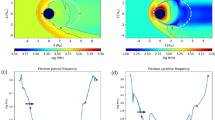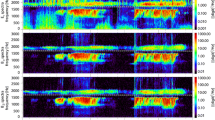Abstract
The China Seismo-Electromagnetic Satellite (CSES) mission was proposed in 2003 and approved in 2013 after ten years’ scientific and engineering demonstrations. To meet the requirement of scientific objectives, the satellite is designed to be in a sunsynchronous orbit with an altitude of 507 km and descending node time of 14:00 LT. The CSES satellite carries 8 instruments, including search-coil magnetometer (SCM), electric field detector (EFD), high precision magnetometer (HPM), GNSS occultation receiver (GOR), plasma analyzer package (PAP), langmuir probe (LAP), high energetic particle package (HEPP) and detector (HEPD), and tri-band beacon (TBB), among which HEPD is provided by Italian Space Agency. The CSES satellite was launched successfully on February 2, 2018, and is planned to operate for 5 years. The CSES mission is the first satellite in China to measure geophysical fields, which will have a lot of application prospects in the study of seismology, geophysics, space sciences, and so on.
Similar content being viewed by others
References
Chen Y T. Earthquake prediction: Retrospect and prospect (in Chinese). Sci China Ser D-Earth Sci, 2009, 39: 1633–1658
Geller R J, Jackson D D, Kagan Y Y, et al. Earthquakes cannot be predicted. Science, 1997, 275: 1616–1616
Wyss M, Aceves R L, Park S K, et al. Cannot earthquakes be predicted? Science, 1997, 278: 487–490
Zhang X, Shen X, Parrot M, et al. Phenomena of electrostatic perturbations before strong earthquakes (2005–2010) observed on DEMETER. Nat Hazards Earth Syst Sci, 2012, 12: 75–83
Parrot M, Benoist D, Berthelier J J, et al. The magnetic field experiment IMSC and its data processing onboard DEMETER: Scientific objectives, description and first results. Planet Space Sci, 2006, 54: 441–455
Gousheva M, Danov D, Hristov P, et al. Quasi-static electric fields phenomena in the ionosphere associated with pre- and post earthquake effects. Nat Hazards Earth Syst Sci, 2008, 8: 101–107
Molchanov O A, Rozhnoi A, Solovieva M, et al. Global diagnostics of ionospheric perturbations associated with seismicity using VLF transmitter signals received on DEMETER satellite. Nat Hazard Earth Syst Sci, 2006, 6: 745–753
Nemec F, Santolík O, Parrot M. Decrease of intensity of ELF/VLF waves observed in the upper ionosphere close to earthquakes: A statistical study. J Geophys Res, 2009, 114: A04303
Rozhnoi A, Solovieva M, Parrot M, et al. VLF/LF signal studies of the ionospheric response to strong seismic activity in the Far Eastern region combining the DEMETER and ground-based observations. Phys Chem Earth Parts A/B/C, 2015, 85–86: 141–149
Zhang X, Zeren Z, Parrot M, et al. ULF/ELF ionospheric electric field and plasma perturbations related to Chile earthquakes. Adv Space Res, 2011, 47: 991–1000
Zeren Z, Shen X H, Cao J B, et al. Statistical analysis of ELF/VLF magnetic field disturbances before major earthquakes. Chin J Geophys-Chin Ed, 2012, 55: 3699–3708
Zeren Z, Shen X H, Zhang X, et al. Possible ionospheric electromagnetic perturbations induced by the Ms7.1 Yushu Earthquake. Earth Moon Planets, 2012, 108: 231–241
Shen X H, Zeren Z, Zhao S f, et al. VLF radio wave anomalies associated with the 2010 Ms7.1 Yushu earthquake. Adv Space Res, 2017, 59: 2636–2644
Cai J T, Zhao G Z, Zhan Y, et al. The study on ionospheric disturbances during earthquakes (in Chinese). Progr Geophys, 2007, 22: 695–701
Parrot M. Statistical analysis of automatically detected ion density variations recorded by DEMETER and their relation to seismic activity. Ann Geophys, 2012, 55: 149–155
Parrot M, Berthelier J J, Lebreton J P, et al. Examples of unusual ionospheric observations made by the DEMETER satellite over seismic regions. Phys Chem Earth Parts A/B/C, 2006, 31: 486–495
Ryu K, Lee E, Chae J S, et al. Seismo-ionospheric coupling appearing as equatorial electron density enhancements observed via DEMETER electron density measurements. J Geophys Res-Space Phys, 2014, 119: 8524–8542
Yan R, Parrot M, Pinçon J L. Statistical study on variations of the ionospheric ion density observed by DEMETER and related to seismic activities. J Geophys Res-Space Phys, 2017, 122: 12,421–12,429
Liu J, Zhang X, Novikov V, et al. Variations of ionospheric plasma at different altitudes before the 2005 Sumatra Indonesia Ms7.2 earthquake. J Geophys Res-Space Phys, 2016, 121: 9179–9187
Shen X H, Zhang X, Liu J, et al. Analysis of the enhanced negative correlation between electron density and electron temperature related to earthquakes. Ann Geophys, 2015, 33: 471–479
Shen X, Zhang X. The spatial distribution of hydrogen ions at topside ionosphere in local daytime. Terr Atmos Ocean Sci, 2017, 28: 1009–1017
Tao D, Cao J, Battiston R, et al. Seismo-ionospheric anomalies in ionospheric TEC and plasma density before the 17 July 2006 M7.7 south of Java earthquake. Ann Geophys, 2017, 35: 589–598
Zhang X M, Shen X H, Zhao S F, et al. The seismo-ionosperic monitoring technologies and their application research development (in Chinese with English abstract). Earthq Sci, 2016, 38: 356–375
Aleksandrin S Y, Galper A M, Grishantzeva L A, et al. High-energy charged particle bursts in the near-Earth space as earthquake precursors. Ann Geophys, 2003, 21: 597–602
Sgrigna V, Carota L, Conti L, et al. Correlations between earthquakes and anomalous particle bursts from SAMPEX/PET satellite observations. J Atmos Sol-Terr Phys, 2005, 67: 1448–1462
Tao D, Battiston R, Vitale V, et al. A new method to study the time correlation between Van Allen Belt electrons and earthquakes. Int J Remote Sens, 2016, 37: 5304–5319
Fidani C, Battiston R. Analysis of NOAA particle data and correlations to seismic activity. Nat Hazards Earth Syst Sci, 2008, 8: 1277–1291
Zhang X, Fidani C, Huang J, et al. Burst increases of precipitating electrons recorded by the DEMETER satellite before strong earthquakes. Nat Hazards Earth Syst Sci, 2013, 13: 197–209
Pulinets S A, Boyarchuk K A. Ionospheric Precursors of Earthquakes. Berlin, Heidelberg, New York: Springer, 2004. 1–287
Nagano I, Mambo M, Hutatsuishi G. Numerical calculation of electromagnetic waves in an anisotropic multilayered medium. Radio Sci, 1975, 10: 611–617
Zhao S F, Liao L, Zhang X. Trans-ionospheric VLF wave power absorption of terrestrial VLF signals (in Chinese with English abstract). Chin J Geophys, 2017, 60: 3004–3014
Shen X, Zhang X, Wang L, et al. The earthquake-related disturbances in ionosphere and project of the first China Seismo-Electromagnetic Satellite. Earthq Sci, 2011, 24: 639–650
Zhao S F, Zhang X M, Zhao Z Y, et al. The numerical simulation on ionospheric perturbations in electric field before large earthquakes. Ann Geophys, 2014, 32: 1487–1493
Nagano I, Rosen P A, Yagitani S, et al. Full wave analysis of the Australian omega signal observed by the Akebono Satellite. IEICE Transactions on Communications, 1993, 76: 1571–1578
Lehtinen N G, Inan U S. Full-wave modeling of transionoephtic propagation of VLF waves. Geophys Res Lett, 2009, 36: L03104
Inan U S, Chang H C, Helliwell R A. Electron precipitation zones around major ground-based VLF signal sources. J Geophys Res, 1984, 89: 2891–2906
Wang F, Zhao Z Y, Changh S S, et al. Radiation of ELF waves by ionospheric artificial modulation into a stratified ionosphere. Chin J Geophys, 2012, 55: 2167–2176
Sorokin V M, Chmyrev V M, Yaschenko A K. Electrodynamic model of the lower atmosphere and the ionosphere coupling. J Atmos Sol-Terr Phys, 2001, 63: 1681–1691
Sorokin V M, Chmyrev V M, Yaschenko A K. Theoretical model of DC electric field formation in the ionosphere stimulated by seismic activity. J Atmos Sol-Terr Phys, 2005, 67: 1259–1268
Kuo C L, Huba J D, Joyce G, et al. Ionosphere plasma bubbles and density variations induced by pre-earthquake rock currents and associated surface charges. J Geophys Res, 2011, 116: A10317
Kuo C L, Lee L C, Huba J D. An improved coupling model for the lithosphere-atmosphere-ionosphere system. J Geophys Res-Space Phys, 2014, 119: 3189–3205
Zhou C, Liu Y, Zhao S, et al. An electric field penetration model for seismo-ionospheric research. Adv Space Res, 2017, 60: 2217–2232
Hao Y Q, Xiao Z, Zhang D H. Multi-instrument observation on coseismic ionospheric effects after great Tohoku earthquake. J Geophys Res, 2012, 117: A02305
Ambrosi G, Bartocci S, Basara L, et al. Seismo-induced perturbations of the inner Van Allen belt: The particle detector of the CSES mission for the investigation. Sci China Tech Sci, 2018, doi: 10.1007/s11431-018-9234-9
Cao J B, Zeng L, Zan F, et al. The electromagnetic wave experiment for CSES mission: Search coil magnetometer. Sci China Tech Sci, 2018, doi: 10.1007/s11431-018-9241-7
Author information
Authors and Affiliations
Corresponding author
Rights and permissions
About this article
Cite this article
Shen, X., Zhang, X., Yuan, S. et al. The state-of-the-art of the China Seismo-Electromagnetic Satellite mission. Sci. China Technol. Sci. 61, 634–642 (2018). https://doi.org/10.1007/s11431-018-9242-0
Received:
Accepted:
Published:
Issue Date:
DOI: https://doi.org/10.1007/s11431-018-9242-0




